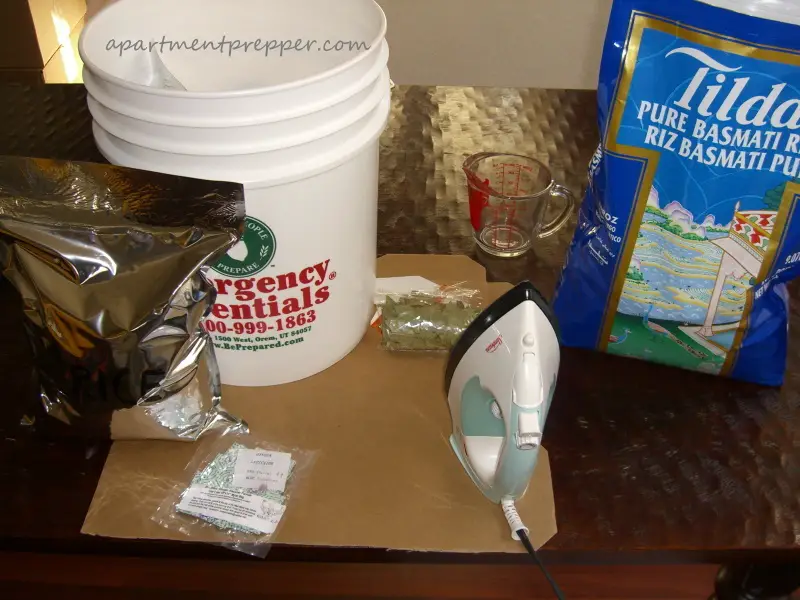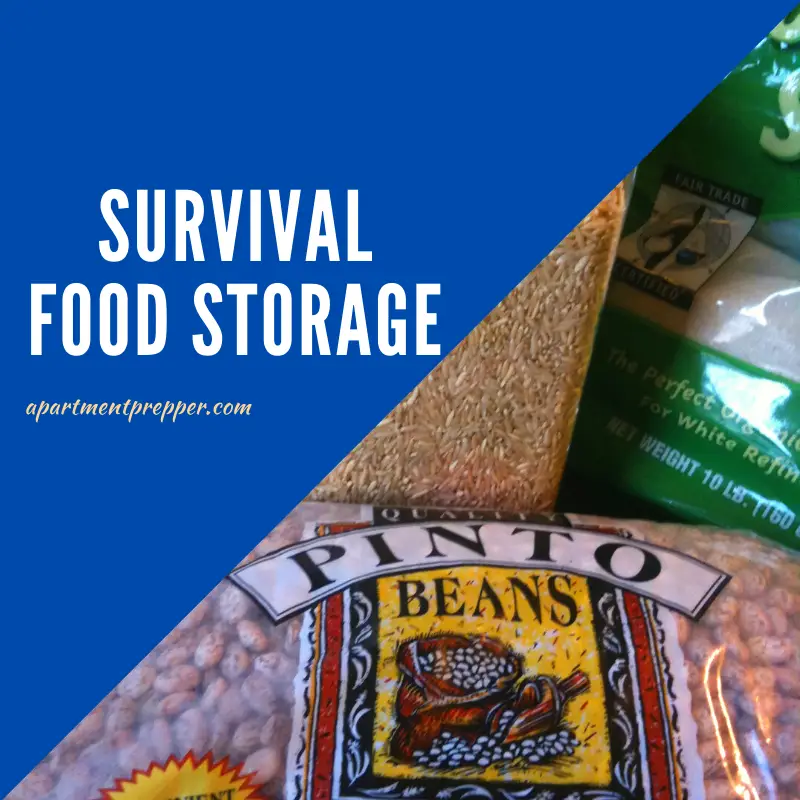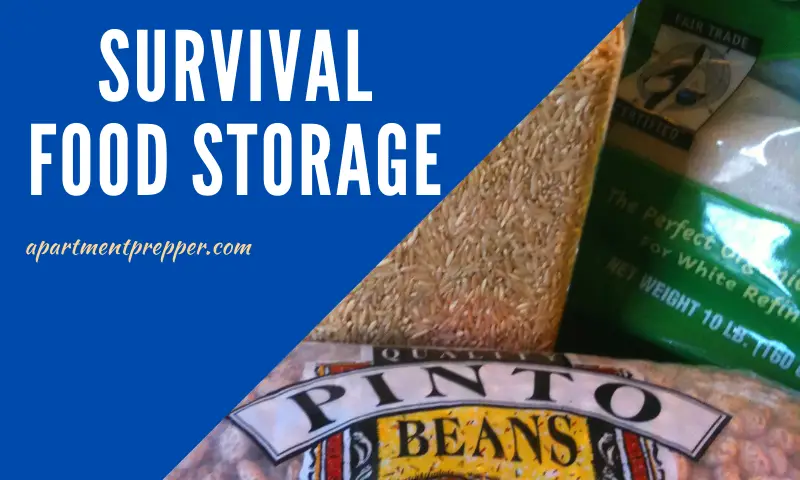This post is by Bernie Carr, apartmentprepper.com
After shopping around for bulk survival food and storage materials, I am finally ready to start storing.
First, I gathered up all my supplies on the dining table:
- Food items such as rice, pasta, pinto beans, etc.
- 5 gallon food grade buckets
- 1 gallon size mylar bags
- oxygen absorbers (300 cc)
- measuring cup
- iron
- masking tape and sharpie marker for labeling
- cardboard to place over the table (under the iron)
- airtight jar to keep extra oxygen absorbers
- bay leaves to ward against weevils

The photo shows the mylar bags, oxygen absorbers, masking tape and jar.
- A few things to note: Before you start, set the iron to the hottest setting. Make sure you set the iron on a covered surface to avoid burning. I used recycled cardboard from a large pizza box, but you should determine what works best for you.
- While these steps are doable with one person, it is easier to do them with two people, so you have someone holding the bag while the other person is ironing across. My husband helped me out on this so it went a bit faster.
- You will need to set aside a solid block of time to do this: Oxygen absorbers start activating as soon as you open the package. If you have to stop and leave them for later, you must store them in an airtight container or they will become useless.
- DO NOT use oxygen absorbers for storing sugar. This will cause the sugar to harden into a block.
We did the following to steps:
- Place one oxygen absorber in the bottom of the mylar bag.
- Pour 12 cups of rice (or whatever you are storing) into the bag. I used a 2 cup measuring cup to as this was quicker than doing it one by one.
- Add another oxygen absorber and one bay leaf on top of the rice. There should be about an inch clearance from the top edge of the bag to where the rice fills up to.
- Line up the sides and across the top of the mylar bag flat.
- Carefully iron across the top, leaving a 1 inch space open on the left corner. Don’t worry, the iron will not stick to the mylar, it actually stays smooth. Do not try to make a fold across the top and iron it: we tried this and it does not seal as well.
- “Burp” the bag to let any remaining air out.
- Now you can iron the remaining space and seal it up. Careful, as the iron can get too hot. About an hour after we started, we noticed the bags were not sealing as well, then we realized the iron had gotten too hot and the automatic shut off activated. Make sure your iron does not overheat.
- Label the bag with a sharpie pen.
- Place the mylar bag in the food grade 5 gallon bucket.
- Keep packaging the same food item into mylar bags following the above steps until the bucket is full.
- Seal up the bucket.
- Label the bucket. I used a masking tape and wrote the contents of the bucket with a sharpie market.
- Store any remaining oxygen absorbers in an airtight jar.
- Store the bucket in a cool, dry area. I cannot store food in the garage as we live in a hot and humid area. Heat and humidity will shorten the life of stored food. For now, the buckets are hidden under the dining table with a long table cloth.

The next day, you will notice the bags look shrunken. This is the oxygen absorber doing its job.
That’s it, the process was actually easier than I thought.
***************************************************************************
We are an affiliate of Amazon.com, which means we received a small commission if you click through one of our Amazon links when you shop, at totally no cost to you. This helps keep the lights on at the blog. Thanks!
About the author:
Bernie Carr is the founder of Apartment Prepper. She has written several books including the best-selling Prepper’s Pocket Guide, Jake and Miller’s Big Adventure, The Penny-Pinching Prepper and How to Prepare for Most Emergencies on a $50 a Month Budget. Her work appears in sites such as the Allstate Blog and Clark.com, as well as print magazines such as Backwoods Survival Guide and Prepper Survival Guide. She has been featured in national publications such as Fox Business and Popular Mechanics. Learn more about Bernie here.



I am tempted to try this method, what is the general length of time food stays edible from using this method,
Many thanks
D
Hello D, great question, glad you brought it up. I may have to write another post about it. The shelf life of stored food varies according to several factors like temperature, heat and humidity. Generally, at a constant 70 degrees, here is a general idea of how long they would last properly stored in a mylar bag with oxygen absorbers: flour-15 years; wheat-20 years; pasta-15 years; pinto beans-20 years; rice-8 years. However, to be on the safe side, I am counting on storing them 3 years, maybe 5 at the most, then I would start rotating them, as in using them up and replacing with a new batch. Hope this helps!
When it comes to emergency preparedness, most people I talk to think that nothing will ever happen to them- I constantly hear “why should I bother”. In today’s world it sounds crazy to talk about storing food. Why bother when restaurants, convenient stores and grocery stores are open 24 hours a day, 7days a week? We have grown up in the age of consumerism and take for granted there will always be food on the shelves. Well, what if there is a national emergency? Or if the unions repeat what happened in France – and stop delivery trucks in protest. What if our government keeps spending and hyper inflation occurs? Just look what happened in Boston! https://survivalist-hub.blogspot.com/. Why not be prepared just in case? It drives me NUTS when people have their heads in the sand!! But I know I am not nuts.
As a father of 3 small children, I have always tried to protect and provide for all their immediate and future necessities. I could not come home and tell my kids there was no food on the shelves. Now, I can sleep in peace having purchased years of emergency food! I love having the peace of mind, the feeling of being empowered– that my family and I are covered with the necessary emergency food, and survival supplies for the next 20 years at TODAY’S prices for what ever comes our way. For more information, go to blog https://survivalist-hub.blogspot.com/.
Yes, I wish more people would take notice and start an emergency plan. The more people start to prepare the better off for everyone. Thanks for visiting!
Thank you for all of the useful information. Just wanted to let you know that i found this website (www.usaemergencysupply.com) where all the supplies are a bit cheaper and just as good. Just wanted to pass the info on. Money saved on supplies is more food stored.
I have purchased mylar bags and oxygen absorbers, and tomorrow I”m getting buckets and even more rice. I’ll follow your procedures and write later how it goes.
I look forward to finding out about your food storage adventure!
Apartment Prepper, I finally got around to doing it. I mylared 6 1-gallon bags of rice. But the buckets, while for 5 gallons, only hold 3 bags. I may have to put less rice in each to fit more bags.
Was pretty easy. Will mylar more rice soon.
That is great! Once you try it, it’s actually easier than it sounds. I did find that some of the buckets had extra space, but not quite enough for another bag. I am glad you are moving along nicely. Thanks for the update!
I didn’t know it could last that long, really amazing that food can be stored for several years and even more than a decade. 🙂
I am interested in following your lead. Right now Im into storing canned goods and ready-to-eat noodles just in case something happens and leave us with no choice but to stay home Thanks for the tips.
Thomas, Canned goods and quick noodles are a great start! You can just get more of those initially and branch out to the long term food storage and you still would be in good shape for an emergency.
Here are the16 reasons people are storing food for your consideration. (If we missed one, let us know in the comment area below!)
One in six Americans presently worry about getting food daily.
Runaway inflation in Germany and Argentina followed the same inflationary path that the US is presently on. With runaway inflation, the price of a loaf of bread doubled daily until it cost billions of the country’s currency units.
The National ID card is expected to be required in order to buy food.
Christians searching the Book of Revelation believe that for about half the 7-year tribulation or 3 ½ years no one will be able to buy or sell without the “mark” (most consider this the ID card.)
Global warming whether real or fabricated will likely be used to control fertilization of crops and tax farmers out of business.
Legislation to prevent people from gardening is being proposed.
Plant gardens if you can, but the majority of our population has no place or time to plant them.
The Doomsday Seed Vault is being built in Norway with the intent of being the only source for seed to grow food worldwide.
The message from Afghanistan and Iraq is that if the food is not centralized and people have their own little supplies, it makes no difference how many guns are against them. They are hard to beat.
If in quarantines, martial law, disasters and emergencies people don’t have their own individual supplies, they will be dependent and helpless like the miserable conditions after hurricane Katrina.
The issue of guns in the possession of the people, food, or the lack of it, has always been used to take the protection of guns away from people. (Cuba, China, Germany etc.)
Imported food from countries with no safety standards for insecticides, fertilizers, bacterial and chemical contamination have entered our country’s food supply and have proven to be very dangerous.
Job loss and illness are hugely reduced in their impact financially and emotionally with a strong savings account of food.
A food supply can help your neighbor, family members or anyone in need.
Storms and weather make food impossible to transport, destroy crops and isolate people from supplies.
The year 2012 and the anticipated global changes are of concern to many for possible food shortages and survival issues.
Serious American crop failures are creating shortages of food to be processed into supplies for people to store. Even though shortages have not appeared in the grocery stores as soon as we become dependent on the 2009 crop everyone will be affected.
So there you have it. Even though our function for almost 30 years has been to pack and ship food to you, our greatest challenge and concern is exactly the same as yours. How long will we be able to get the raw materials that we use to prepare your food? Our answer is the same as yours and that is to get in as many raw materials as we possibly can as quickly as we can. View additional information on facebook Steve Mynhier